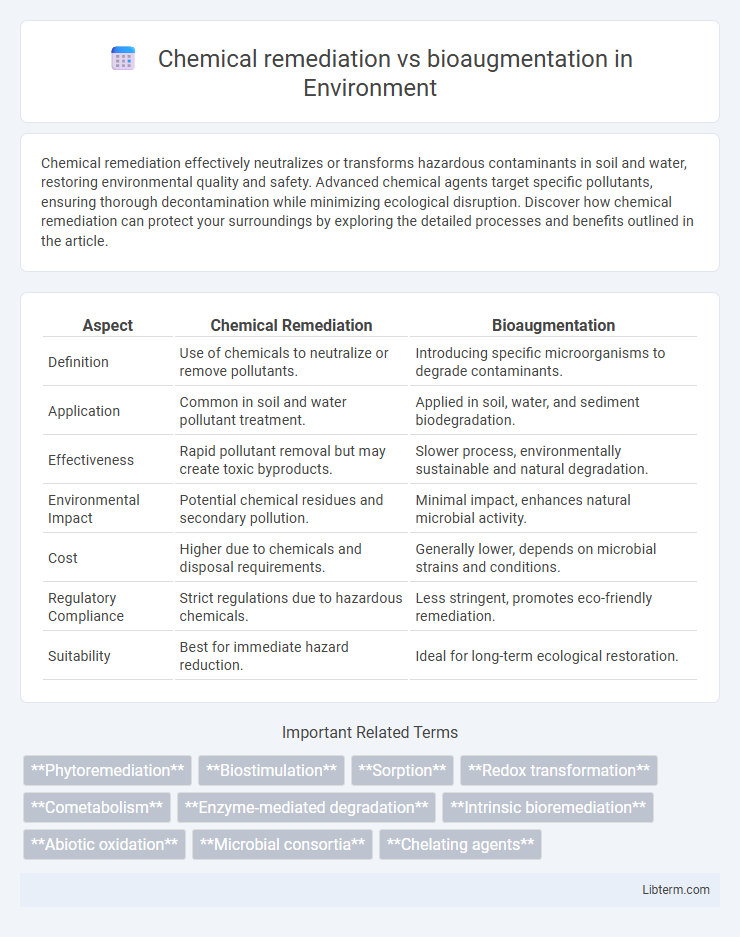Chemical remediation effectively neutralizes or transforms hazardous contaminants in soil and water, restoring environmental quality and safety. Advanced chemical agents target specific pollutants, ensuring thorough decontamination while minimizing ecological disruption. Discover how chemical remediation can protect your surroundings by exploring the detailed processes and benefits outlined in the article.
Table of Comparison
| Aspect | Chemical Remediation | Bioaugmentation |
|---|---|---|
| Definition | Use of chemicals to neutralize or remove pollutants. | Introducing specific microorganisms to degrade contaminants. |
| Application | Common in soil and water pollutant treatment. | Applied in soil, water, and sediment biodegradation. |
| Effectiveness | Rapid pollutant removal but may create toxic byproducts. | Slower process, environmentally sustainable and natural degradation. |
| Environmental Impact | Potential chemical residues and secondary pollution. | Minimal impact, enhances natural microbial activity. |
| Cost | Higher due to chemicals and disposal requirements. | Generally lower, depends on microbial strains and conditions. |
| Regulatory Compliance | Strict regulations due to hazardous chemicals. | Less stringent, promotes eco-friendly remediation. |
| Suitability | Best for immediate hazard reduction. | Ideal for long-term ecological restoration. |
Introduction to Chemical Remediation and Bioaugmentation
Chemical remediation involves the use of synthetic chemicals or physical processes to neutralize, remove, or degrade contaminants in soil, water, or air, offering rapid detoxification of hazardous substances such as heavy metals and chlorinated solvents. Bioaugmentation employs specific strains of microorganisms to enhance the biodegradation of pollutants, leveraging natural metabolic pathways to restore contaminated environments over time. Both techniques serve as vital approaches in environmental cleanup, where chemical remediation provides immediate results and bioaugmentation offers sustainable, long-term degradation of organic contaminants.
Defining Chemical Remediation Methods
Chemical remediation methods involve the use of chemical agents to neutralize, degrade, or immobilize contaminants in soil, water, or air, often through oxidation, reduction, or precipitation reactions. Common techniques include chemical oxidation using agents like hydrogen peroxide or potassium permanganate, and chemical reduction employing zero-valent iron or sulfides to transform harmful compounds into less toxic forms. These methods provide rapid contaminant treatment but require careful control to avoid secondary pollution and ensure effective contaminant interaction.
Principles of Bioaugmentation
Bioaugmentation enhances contaminated sites by introducing specific microbial strains that degrade pollutants, leveraging natural biodegradation pathways to restore environmental quality. It relies on selecting and applying microbial consortia with targeted enzymatic capabilities to accelerate the breakdown of organic contaminants such as hydrocarbons, chlorinated solvents, and heavy metals. Unlike chemical remediation that employs reactive agents for pollutant neutralization, bioaugmentation promotes sustainable biodegradation through microbial metabolism and ecosystem balance.
Key Differences Between Chemical Remediation and Bioaugmentation
Chemical remediation relies on the use of chemical agents to neutralize or remove contaminants from soil or water, often resulting in rapid pollutant breakdown but potential chemical residues. Bioaugmentation employs specific microorganisms to degrade organic pollutants naturally, enhancing the biodegradation process without introducing harmful substances. Key differences include the mode of action, with chemical remediation using abiotic processes versus bioaugmentation leveraging biological activity, and the environmental impact, where bioaugmentation is typically more sustainable and eco-friendly.
Advantages of Chemical Remediation
Chemical remediation offers rapid contaminant removal by using reactive agents that break down pollutants efficiently, making it suitable for emergency responses and heavily polluted sites. It provides precise control over treatment conditions, enabling targeted degradation of complex chemical compounds such as chlorinated solvents and heavy metals. This method often requires less time compared to bioaugmentation, reducing site closure durations and minimizing long-term exposure risks.
Benefits of Bioaugmentation in Environmental Cleanup
Bioaugmentation enhances environmental cleanup by introducing specialized microbial strains that accelerate the degradation of toxic pollutants, outperforming traditional chemical remediation methods. This biological approach promotes sustainable soil and water restoration, reduces chemical residues, and minimizes secondary environmental impacts. Ultimately, bioaugmentation offers cost-effective, eco-friendly solutions for the remediation of hazardous contaminants like hydrocarbons, heavy metals, and chlorinated solvents.
Limitations and Challenges of Chemical Remediation
Chemical remediation faces limitations such as the potential release of toxic byproducts, incomplete contaminant degradation, and high operational costs. The process often requires intensive energy input and specialized equipment, which hinders its applicability in large or complex sites. Additionally, chemical methods may negatively impact soil microbial communities and disrupt ecological balance, restricting long-term sustainability.
Bioaugmentation: Limitations and Potential Risks
Bioaugmentation involves the introduction of specialized microbial strains to enhance the degradation of pollutants in contaminated environments, but its effectiveness is limited by factors such as microbial survival, competition with native microbes, and environmental conditions like pH and temperature. Potential risks include the unintended spread of non-native microbes, disruption of local microbial ecosystems, and the possible transfer of antibiotic resistance genes. Careful assessment of site-specific conditions and microbial compatibility is essential to mitigate these risks and improve bioaugmentation outcomes.
Case Studies: Real-World Applications
Case studies in chemical remediation reveal its efficacy in rapidly reducing toxic contaminants like chlorinated solvents in industrial sites, with examples such as the successful cleanup of the Rocky Mountain Arsenal landfill. Bioaugmentation demonstrates sustainable restoration by introducing specialized microbial strains to degrade pollutants, evidenced in the Exxon Valdez oil spill where hydrocarbon-degrading bacteria enhanced natural attenuation. Comparative analyses highlight bioaugmentation's advantage in preserving soil ecology, while chemical remediation offers quicker contaminant reduction but often involves higher costs and secondary effects.
Conclusion: Selecting the Right Approach for Contaminant Remediation
Chemical remediation offers rapid contaminant breakdown through advanced oxidants and catalysts, making it suitable for acute pollution scenarios. Bioaugmentation enhances microbial populations to biodegrade pollutants naturally, ideal for long-term site restoration with minimal ecological disruption. Choosing the right method depends on contamination type, site conditions, cleanup timeline, and environmental impact considerations.
Chemical remediation Infographic

 libterm.com
libterm.com